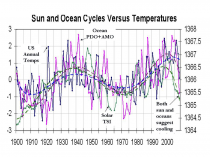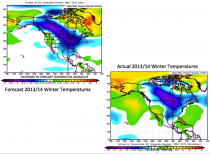Craig Rucker
It is not surprising that climate alarmists, who desire above all else blind allegiance to their cause, would demand all school teachers toe the “official party line” and quash any dissent on the subject of man-made global warming in their classroom. What is absurd is that any teacher, or free-thinking person for that matter, would listen to them. In the past, of course, those who would even suggest such censorship would have been ridiculed and viewed as enemies of intellectual freedom. But the ‘times-they-are-a-changin.’ News outlets such as the BBC and LA Times may benefit from freedom of speech, however, they are among the first to push censorship on those with whom they disagree.

Like all who want to limit free speech, the alarmists claim they are doing a great public service. After all, since 97 percent of total scientists are in agreement with them, why give equal (or any) press to the pitiful 3% who remain deniers? Sounds reasonable, right? Well not really.
Putting aside the reprehensible term “denier,” an obvious reference to those who deny the Holocaust (which is even more offensive to climate skeptics who happen to be Jewish), is there any validity to 97% claim? If skeptics made the same 97% pitch in reverse, would the media demand they produce a solid source or study to back it up? You bet they would! And it’s doubtful any study skeptics actually did produce would be simply accepted at face value - no, the media would scrutinize it and put it through the ringer to see if it passed the smell test. But alas, such inquisitiveness is lacking whenever a climate alarmist squeals “consensus.”
So where does this 97% mantra come from? Well one major source to be sure is an April 2013 research paper by Australian scientist John Cook [John Cook et al., Environ. Res. Lett. 8 024024]. Now Cook did claim his research showed “97.1% endorsed the consensus position that humans are causing global warming.” And others, eager to promote his study, used his research to claim that “97.1% endorsed the consensus position that humans are causing at least 50.1% of the warming of the Earth in the last quarter of the 20th Century.” But a closer look shows something much different. Cook’s data actually showed only a lame 64 of 11,944 papers surveyed made this bold claim; the rest either ignored the subject altogether (two-thirds did not address the issue at all), did not quantify any percentage of warming they perceived to be caused by human activity, or flatly rejected the anthropogenic global warming (AGW) position. A consensus? Hardly.
Indeed, the gleeful distortion of Cook’s actual findings by the alarmists (with Cook himself one of the perpetrators) is just another example of the attempt to justify the canonization of pseudo-scientific dogma despite the real-world climate data. This near-conspiratorial attempt to declare an end to scientific research which might yield conclusions that are “inconvenient” for these dogmatists would be laughable were it not for the insistence that school children be indoctrinated with their propaganda.
The politicization of “science” in the public school system is just plain wrong, as is demonizing those who disagree or doubt the party line anywhere in society. Indeed, it is especially sad to see the press, even the National Journal itself, all too often mention “the 97% solution” as if it were the gold standard, the gospel that cannot be questioned by any sane person. They are being made look particularly bad, as polls indicate, as the public becomes more skeptical of alarmist claims. A recent Rasmussen poll found only 20% of the public thinks the debate about the science of climate change is over. Apparently the 97% mantra becomes meaningless to many when real-world climate data shows no increase in global temperatures over the past 17 years.
So what should children be taught? Well, how about both sides for starters. Yes, let the alarmists make their case. But what’s the fear that students should also learn that other, very credible scientists have published peer-reviewed papers attributing significant impacts on the Earth’s climate to solar activity (or inactivity). They can be taught that the Earth’s climate changes in cycles over long periods of time, and they’re impacted by changes in tides, ocean currents, winds, volcanoes, solar activity, meteors and comets, and of course to a limited extent, human activities. What they should not be taught is to parrot a political line, but for students to think for themselves, challenge ideas, and investigate every angle. Students should be taught that the scientific method demands that all scientists be skeptics for it is by being skeptical that a number of scientific “law” that stood for centuries have been disproven by better research.
If there is any national standard, then, it must be one that takes no position on the science itself, which is ever changing, but rather on the methodology for investigating the myriad scientific questions that have been and might be raised regarding how the Earth’s climate has changed all along.
By Daniel Nebert, MD
The 2013 report by the United Nations Intergovernmental Panel on Climate Change (IPCC) states that “global warming is unequivocal and human influence has been the dominant cause since the mid-20th century.” During his State of the Union speech in January, President Obama declared “the debate is settled. Climate change is a fact.” As a physician-scientist who has carried out basic research for more than 50 years, I agree that we should not pollute the planet unnecessarily; however, I find the above statements far beyond the truth.
Estimates of numbers of scientists who “believe” in global warming range between 40 percent and more than 99 percent. Those in disagreement have been called “skeptics,” “deniers,” and “nonbelievers.” However, “believing” and “denying” are terms used in “consensus science,” not terms in “basic science.”
What’s the difference? Basic science is defined as knowledge about, or study of, the natural world based on facts learned through experiments and observations. A theory (hypothesis) is tested by performing experiments and interpreting results either to prove or disprove the hypothesis in a way to minimize uncertainty. It’s best if those doing the experiments are “blinded”, i.e. samples are coded so that those doing the experiments are not biased toward any expected outcome. These experiments must also be repeated by other groups to confirm the original findings. Only after data have been properly collected, vetted and thoroughly corroborated, do we have a conclusion - with the least amount of uncertainty needed to establish a scientific fact.
In contrast, consensus science is what the majority in a particular field of study agree upon might be true. The consensus may or may not turn out to be confirmed by further research. For example, 15 years ago simulation models predicted that all Arctic ice would disappear by September 2013. In fact, Arctic ice thickness doubled between summer of 2012 and summer of 2013. Other forecasts 15 years ago included substantial melting of Antarctic ice, warming of global temperatures, and rising sea levels. Although carbon dioxide levels have risen during the past 15 years, the Antarctic ice shelf has become thicker, there’s been no increase in global temperatures and (if anything) global sea levels have slightly decreased. Thus, these simulation models included much uncertainty and, to date, all have been proven to be invalid.
There are many instances in which “established science” has been overturned by further experiments. In other words, science is never completely irrefutable.
For example, mad cow disease and the human equivalent, Creutzfeldt-Jakob disease, were degenerative brain diseases of unknown cause. After 10 years of experiments, neurologist Stanley Prusiner reported in 1982 that these diseases were caused by a virus-like protein which he named “prion” (derived from “protein” and “infectious"). Almost every scientist laughed, because viruses had been well known to always be made of DNA or RNA. Prusiner persisted, however, because he was convinced the consensus was wrong. He proved to be correct and was awarded the 1997 Nobel Prize for medicine or physiology for his novel discovery. Prions are now realized to affect tissues other than brain and, in fact, are found even in lower organisms such as yeast.
For decades, peptic ulcer was believed to be caused by mental stress and excess stomach acid. Following many years of experiments, physicians Barry Marshall and Robin Warren reported in 1985 that peptic ulcer was caused by Heliobacter pylori. This finding forever changed the field of ulcer research: Instead of treating ulcers with antacid medications and/or surgery, antibiotics could now kill the bacteria and cure the disease! Marshall and Warren were awarded the 2005 Nobel Prize for medicine or physiology for this breakthrough.
It is a fact that Earth’s climate has been changing for 4.5 billion years. Indeed, fossil records in the Americas over the past 16,000 years have confirmed countless serious droughts lasting many decades, sometimes hundreds of years. Climate is measured in centuries; today’s global warming “scientists” are talking about weather (measured in months or years). Is it reasonable, when U.S. debt is increasing at a rate of $3.7 billion each day, for any taxpayer money to be spent on consensus science speculation?
Daniel Nebert, MD, is professor emeritus at the Cincinnati College of Medicine and Cincinnati Children’s Hospital. He lives in Wilsonville.
Joseph D’Aleo, CCM in HLN
Hurricane Arthur (as viewed from the International Space Station) slammed the Outer Banks of NC and then brushed New England, contributed to the rains, well needed though untimely on the 4th.
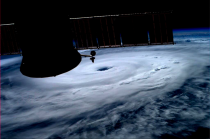
Early this spring, we (weatherbell.com) predicted on this page and on our site that there would be more threats than normal to the east coast and New England this season despite the fact there would be overall less activity in the deep tropics and fewer storms that made their way from Africa (called Cape Verde storms). This was because of cooler than normal tropical water, dusty, dry air blowing off the Sahara into the high atmosphere, and increased vertical wind shear because of a developing El Nino. This shear is in the form of anomalous westerly winds at high levels that come east from the warm eastern Pacific and blow the tops off of thunderstorms that are trying to organize in waves moving west in the subtropical Atlantic.
The ocean from the Bahamas north off the east coast where the Gulf Stream carries warmth Poleward, is warmer than normal and is north of the unfavorable dry Saharan air and wind shear.
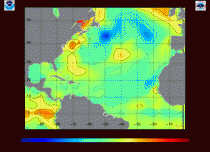
Atlantic sea temperature anomalies NHC Enlarged
_thumb.jpg)
Atlantic Saharan Dust layer CIMSS Enlarged
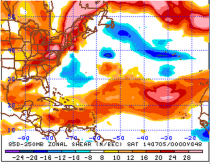
Atlantic vertical wind shear Enlarged
We forecast that old fronts or disorganized waves from the east would get their act together often closer to the mainland like Arthur did. Hurricane Carol, one of the worst New England storms organized over the Bahamas and slammed Long island and eastern New England in short order in 1954.
Arthur developed last week just off the southeast coast and feeding off the Gulf Stream, developed into a Category 2 hurricane crossing the Outer Banks of North Carolina before brushing New England in a weakened state. It brought some needed rains but is a potential omen of storms to follow.
The oceans and sun are the primary drivers to the climate regimes we find ourselves in when it comes to hurricanes, tornadoes, droughts and floods, heat and cold, and snowstorms. In terms of the ocean, the current combination of a cool Pacific and warm Atlantic Multidecadal modes is most like the 1950s. That was a period of drought in the southern Plains like the past few years, and a decade where 6 hurricanes created havoc on the Atlantic Coast. We had Carol, Edna, and Hazel in 1954, Connie and Diane in 1955 and Donna in 1960.
The ocean cycles average about 60 years and 60 years ago was the hurricane era of the middle 1950s.
A lesson from the 1950s is that you can have multiple landfalling storms in a season, even ones with a normal number of Atlantic named systems. As the Atlantic cooled, the flurry of landfalling storms ended in 1960 with Donna. The Atlantic warmed again in 1995 and the Pacific cooled after 1998. Floyd developed in 1999, Isabel made landfall in the Mid Atlantic in 2003, Irene hit New York and western New England in 2011 and Sandy, New Jersey and New York City in 2012. Arthur made a close pass this week and there may be more.
The Atlantic will cool within the next 5 years in its 60-year cycle and then both oceans will be cold. We can rest easier in the east in the summer and fall. Our winter temperatures will accelerate down though.
The 1960s and 1970s had the oceans go into their cold phase and the sun turn relatively quiet and the globe cooled. A series of volcanoes in the 1960s also contributed by creating an aerosol layer high up that reduced sunlight. There was also a concern about what was called “the human volcano”, man-made particulates that were also blocking sunlight. This is no longer an issue in the US with scrubbers on our coal plants and cleaner, more efficient cars, but a real one in China and India.
Some leading scientists and the government then warned of the possibility of a return to the little ice age conditions we experienced from the 1600s to early 1800s. The CIA in a 1974 report said “There is a growing consensus among leading climatologists that the world in undergoing a cooling trend… already causing major economic problems throughout the world.” Sound familar? See thisLeonard Nimoy video from 1978. “Climate experts believe the next ice age is on its way.”
Though Wikipedia will list reasons why this fear then never really happened, you can see evidence here that it did.
These factors cooled the globe then, but then from 1979 to 1998 when the sun rebounded and the oceans cycled back warm, the globe warmed again. Man has the arrogance to think we control the planet’s climate. We do play a role with urbanization, deforestation and locally where pollution is an issue but these effects are small and localized relative to the main, powerful natural forcings. See how US temperature cycles match to these cycles in the sun and ocean and not well with CO2, which has risen this whole period.
The solar has begun its downwards spiral after 1995, accelerating after 2000 and the oceans have begun cooling. Global warming has ceased for 12 to 20 years (depending on the data and region). As the Atlantic cools and all these three factors synchronize, look for temperatures to accelerate down. Throw in a major volcano (which can cool the earth a half degree) and we will have to cue Mr. Spock again.
We will cool like we did in the 1960s and 1970s, and, as we will explain in the next story, then potentially like the early 1800s. This will have major negative, even dangerous impacts on our region especially given the unwise and ultimately very costly energy policies of the EPA and state elected officials. Increasing energy prices also cause the cost of all goods and services to rise, increasing the stress further on those on fixed income and the poor and middle class. Dr. Frank Clemente of Penn State University explains the risk here in this IEA report.
----------
My talk at the Heartland was on the cold and snow on the increase (around minute 17)
Broadcast live streaming video on Ustream
Joseph D’Aleo, CCM
I do a local column in the Weeklies in southern New Hampshire addressing weather and climate issues. here was my latest column posted Friday, June 20, 2014.
I started weather forecasting in the 1970s for CBS in New York City for local radio, TV and the network show Energy and then as a college professor at Lyndon State College in Vermont where I taught weather and climate analysis and forecasting, and with my students started telephone, radio and ski area forecasting.
We had tools that were very primitive relative to today. Weather forecasters then depended on pattern recognition and empirical rules developed over the years. We looked globally and at all levels of the atmosphere. Computer models were in their infancy extending out with surface forecasts just 2 days. There were no 7 or even 5 day forecasts on television. The third day was considered an outlook.
I left the college in 1980 to join John Coleman in Chicago where we produced Good Morning America weather and plan for the Weather Channel (TWC), which we started with the helps of many of my former students in 1982. The early 80s saw a technology revolution to computerized weather data and graphics and real time local radars. TWC started right at that transition and pioneered new ways of doing both forecasting and TV weather.
The science greatly advanced the next two decades with the explosion of satellite delivery of information and graphics and then the internet and availability of data and global computer modeling going out to 16 days into the future in detail. These models are now run multiple times a day and multiple times in every run (called ensembles) to give forecasters an idea of the range of possibilities and degree of confidence in their outlooks. Model skill has increased in the first 7 to 8 days enough so now the TV meteorologists routinely do a 7-day forecast.
Even though the tools have improved, the best forecasters are the ones like my students and the old timers that understand the basics and can better determine which computers to believe and why and how to interpret what it means for the local area. In my company, Weatherbell.com, we cover the whole world for our clients, extending the challenge. We have to worry about unusual cold and snow in southern Brazil, frigid air in Europe, a slow monsoon onset in India, a heat wave in China, not enough rain in West Africa as well as a snowstorm in New England.
To do so, we at Weatherbell.com developed our own statistical models that combine factors like El Nino and La Nina, the longer term states of the oceans (Multidecadal Oscillations in the Pacific and Atlantic), all the solar variables that affect our weather, the winds in the tropical and temperatures in the polar high atmospheres, the magnitude and location of any volcanism, and patterns of soil moisture and snow cover patterns.
Sometimes like this past winter, other strong localized anomalies show up that override all other factors. A very warm water pool that developed after the super La Nina of 2010/11 in the Pacific northwest of Hawaii grew as it drifted to the Gulf of Alaska last summer and fall. After record Alaska snow and cold in the prior two winters, this warm pool deflected the jet stream north into Alaska making last winter warmer there. The jet stream then turned south into Canada and the central United States forming the ‘polar vortex’, driving arctic and at times Siberian air south in a steady stream from November into the spring.
In the end we have found, the warm and cold pools in the ocean really drive the dominant weather regimes, where it will be cold or warm, and where storms track and thus where it will be wet or dry, and in winter, snows will tend to fall. And we see strong evidence that the sun drives these ocean patterns.
This extreme cold scenario like this past winter happened in the 1976-79, 1916-1918 periods in both cases, a few years after strong La Ninas and quiet sun periods like this past winter.
Seeing that evolution, Weatherbell told our clients last summer that a very cold winter was coming despite the official government climate center forecast of a warm winter.
Indeed 2013/14 brought the coldest December to March ever in Chicago since records began in 1872. It was the 3rd snowiest there, snowiest ever in Detroit and other spots, and second snowiest in Philadelphia. The amount of ice on the Great Lakes set an all time record, well above normal in every week, peaking at 92% coverage in March and not disappearing entirely until June 10.
That ocean warm pool will persist at least into next winter and the El Nino that is coming on will settle near the dateline (called a Modoki El Nino) as it did in 2002/03, 2009/10.
These two factors argue for the cold last year over the central to shift further east - over us. The El Nino southern storm track will have California and Texas farmers dancing in the rain. You can expect another snowy winter on the east coast where we already have had 12 major impact snowstorms this decade just 4 years in, beating out the old record of 10 in the 1960s and the 2000s.
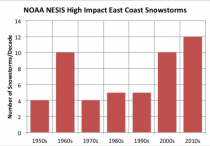
Enlarged
Climate forecasters whose business success depends on getting it right will tell you these same natural factors that determine our seasonal weather patterns can also explain all the past climate cycles and extremes very nicely.
Tallbloke’s Talkshop
Phys.org finds a nice way of saying the doomsters have completely misunderstood the reason why the West Antarctic Ice Sheet outlet has been thinning. New research finds hotter than previously thought geothermal activity underneath the glacier. This means the animated model showing massive WAIS recession by 2350 Cabot Institute director Prof. Rich Pancost was scaring the punters with down at SPRI last week is junk science:
Thwaites Glacier, the large, rapidly changing outlet of the West Antarctic Ice Sheet, is not only being eroded by the ocean, it’s being melted from below by geothermal heat, researchers at the Institute for Geophysics at The University of Texas at Austin (UTIG) report in the current edition of the Proceedings of the National Academy of Sciences.
The findings significantly change the understanding of conditions beneath the West Antarctic Ice Sheet where accurate information has previously been unobtainable.
The Thwaites Glacier has been the focus of considerable attention in recent weeks as other groups of researchers found the glacier is on the way to collapse, but more data and computer modeling are needed to determine when the collapse will begin in earnest and at what rate the sea level will increase as it proceeds. The new observations by UTIG will greatly inform these ice sheet modeling efforts.

Using radar techniques to map how water flows under ice sheets, UTIG researchers were able to estimate ice melting rates and thus identify significant sources of geothermal heat under Thwaites Glacier. They found these sources are distributed over a wider area and are much hotter than previously assumed.
The geothermal heat contributed significantly to melting of the underside of the glacier, and it might be a key factor in allowing the ice sheet to slide, affecting the ice sheet’s stability and its contribution to future sea level rise.
The cause of the variable distribution of heat beneath the glacier is thought to be the movement of magma and associated volcanic activity arising from the rifting of the Earth’s crust beneath the West Antarctic Ice Sheet.
Read more here.
Climate Depot
Professor’s fellowship ‘terminated’ after WSJ OpEd declaring ‘the left wants to stop industrialization - even if the hypothesis of catastrophic, man-made global warming is false’
Prof. Caleb Rossiter: ‘Just two days after I published a piece in the Wall Street Journal calling for Africa to be allowed the ‘all of the above’ energy strategy we have in the U.S., the Institute for Policy Studies (IPS) terminated my 23-year relationship with them...because my analysis and theirs ‘diverge.’
IPS email of ‘termination’ to Rossiter: ‘We would like to inform you that we are terminating your position as an Associate Fellow of the Institute for Policy Studies...Unfortunately, we now feel that your views on key issues, including climate science, climate justice, and many aspects of U.S. policy to Africa, diverge so significantly from ours’
By: Marc Morano - Climate Depot Exclusive
Dr. Caleb Rossiter was “terminated” via email as an “Associate Fellow” from the progressive group Institute for Policy Studies (IPS), following his May 4th, 2014 Wall Street Journal OpEd titled “Sacrificing Africa for Climate Change,” in which he called man-made global warming an “unproved science.” Rossiter also championed the expansion of carbon based energy in Africa. Dr. Rossiter is an adjunct professor at American University. Rossiter holds a PhD in policy analysis and a masters degree in mathematics.
In an exclusive interview with Climate Depot, Dr. Rossiter explained:
“If people ever say that fears of censorship for ‘climate change; views are overblown, have them take a look at this: Just two days after I published a piece in the Wall Street Journal calling for Africa to be allowed the ‘all of the above; energy strategy we have in the U.S., the Institute for Policy Studies terminated my 23-year relationship with them...because my analysis and theirs ‘diverge.’”
“I have tried to get [IPS] to discuss and explain their rejection of my analysis,’ Rossiter told Climate Depot. “When I countered a claim of ‘rapidly accelerating’ temperature change with the [UN] IPCC’s own data’, showing the nearly 20-year temperature pause - the best response I ever got was ‘Caleb, I don’t have time for this.’”
[Climate Depot Note: Intimidation of skeptical scientists has been well documented. Climate scientist Dr. Lennart Bengtsson - who converted from warmist to skeptic - resigns from skeptical group after ‘enormous group pressure’ from warmists - Now ‘worried about my health and safety’ - ‘Colleagues are withdrawing from joint authorship’]
Caleb Rossiter
Climate Depot has obtained a copy of a May 7, 2014 email that John Cavanagh, the director of IPS since 1998, sent to Rossiter with the subject “Ending IPS Associate Fellowship.”
“Dear Caleb, We would like to inform you that we are terminating your position as an Associate Fellow of the Institute for Policy Studies,” Cavanagh wrote in the opening sentence of the email.
“Unfortunately, we now feel that your views on key issues, including climate science, climate justice, and many aspects of U.S. policy to Africa, diverge so significantly from ours that a productive working relationship is untenable. The other project directors of IPS feel the same,” Cavanagh explained.
“We thank you for that work and wish you the best in your future endeavors,” Cavanagh and his IPS associate Emira Woods added.
Rosstier’s May 4, 2014 Wall Street Journal OpEd pulled no punches. Rossiter, who holds a masters in mathematics, wrote: “I started to suspect that the climate-change data were dubious a decade ago while teaching statistics. Computer models used by the U.N. Intergovernmental Panel on Climate Change to determine the cause of the six-tenths of one degree Fahrenheit rise in global temperature from 1980 to 2000 could not statistically separate fossil-fueled and natural trends.”
His Wall Street Journal OpEd continued: “The left wants to stop industrialization - even if the hypothesis of catastrophic, man-made global warming is false.” He added: “Western policies seem more interested in carbon-dioxide levels than in life expectancy.”
“Each American accounts for 20 times the emissions of each African. We are not rationing our electricity. Why should Africa, which needs electricity for the sort of income-producing enterprises and infrastructure that help improve life expectancy? The average in Africa is 59 years - in America it’s 79,” he explained.
“How terrible to think that so many people in the West would rather block such success stories in the name of unproved science,” he concluded his WSJ OpEd.
Rossiter’s and IPS seemed a natural fit, given Rossiter’s long history as an anti-war activist. IPS describes itself as “a community of public scholars and organizers linking peace, justice, and the environment in the U.S. and globally. We work with social movements to promote true democracy and challenge concentrated wealth, corporate influence, and military power.
But Rosstier’s credentials as a long-time progressive could not trump his growing climate skepticism or his unabashed promotion of carbon based fuels for Africa.
Rossiter’s website describes himself as “a progressive activist who has spent four decades fighting against and writing about the U.S. foreign policy of supporting repressive governments in the formerly colonized countries.”
“I’ve spent my life on the foreign-policy left. I opposed the Vietnam War, U.S. intervention in Central America in the 1980s and our invasion of Iraq. I have headed a group trying to block U.S. arms and training for “friendly” dictators, and I have written books about how U.S. policy in the developing world is neocolonial,” Rossiter wrote in the Wall Street Journal on May 4.
Rossiter’s Wall Street Journal OpEd continued: “The left wants to stop industrialization - even if the hypothesis of catastrophic, man-made global warming is false. John Feffer, my colleague at the Institute for Policy Studies, wrote in the Dec. 8, 2009, Huffington Post that ‘even if the mercury weren’t rising’ we should bring ‘the developing world into the postindustrial age in a sustainable manner.’ He sees the ‘climate crisis [as] precisely the giant lever with which we can, following Archimedes, move the world in a greener, more equitable direction.”
“Then, as now, the computer models simply built in the assumption that fossil fuels are the culprit when temperatures rise, even though a similar warming took place from 1900 to 1940, before fossil fuels could have caused it. The IPCC also claims that the warming, whatever its cause, has slightly increased the length of droughts, the frequency of floods, the intensity of storms, and the rising of sea levels, projecting that these impacts will accelerate disastrously. Yet even the IPCC acknowledges that the average global temperature today remains unchanged since 2000, and did not rise one degree as the models predicted.
“But it is as an Africanist, rather than a statistician, that I object most strongly to ‘climate justice.’ Where is the justice for Africans when universities divest from energy companies and thus weaken their ability to explore for resources in Africa? Where is the justice when the U.S. discourages World Bank funding for electricity-generation projects in Africa that involve fossil fuels, and when the European Union places a ‘global warming’ tax on cargo flights importing perishable African goods?”
------------
November 20, 2012: Good Germans, Munich, Brownshirts, Deniers, Churchill: Enough with the World War II Analogies!
Here is what my friend and anti-imperial compatriot John Tirman, executive director of the M.I.T. Center for International Studies, “tweets” about me and others who are not convinced that industrial emissions are the primary cause of the one degree rise in global average temperature since 1860 - or that this historically minuscule rise, whatever its reasons, is a primary cause of random storms and droughts: “One day, climate change deniers will be viewed like Holocaust deniers are now. #sandy #climatechange’ Ouch.
How am I, a statistician who teaches about the uncertainty of exploratory computer climate models in separating human-induced warming from natural fluctuations of various cycles and extreme randomness (an uncertainty that is openly acknowledged by the modelers themselves, who call their models “scenarios” and not “predictions"), analogous to someone who denies that the Nazis planned and carried out the murder of six million Jewish civilians?
Can’t I just be called an “industrial-emissions-warming-catastrophe” skeptic, honoring Diogenes, Socrates, and the core tradition of scientific thought, the refusal to accept claims “on authority” without testing them with reality? Skepticism has brought us a better understanding of our solar system (thanks, Copernicus and Gallileo) and our universes big and little (thanks, Einstein and Heisenberg), the end of the unjust and brutal social systems of monarchy, feudalism, slavery, imperialism, and colonialism, as well as the modern medicines and treatments of water, crops, and materials that have extended our lives some 50 years on average from the 1600’s. Skeptic, please.
Please, call me a skeptic. And lay off World War II.
by Dr. Tom Sheahen, MIT
Q. On TV I saw that the ice in Antarctica is collapsing, and that will raise sea level and inundate cities. Others reports say this will take thousands of years. How serious is the problem?
What you are witnessing here is a result of confusion between the public perception of the ordinary meaning of words, and the very special definitions used in scientific discourse.
Geologists deal with changes in the earth that occur over epochs of millions of years. Anything that happens in less than 10,000 years is “sudden,” and something happening in only 1,000 years is “instantaneous.” To geologists, the word “collapse” is appropriate for a 10,000 year process.
A hot-topic in the media these days has to do with the West Antarctic Ice Shelf (WAIS), a region comprising about 8% of the ice covering Antarctica. Within that region, there are two glaciers that are sliding down to the sea at a steady pace, as glaciers always do. They comprise about 10% of the WAIS, less than 1% of Antarctic ice. This descent has been in progress for several thousand years, and is neither new nor man-caused. It will go on for a few thousand more, after which they’ll be gone. In the parlance of geology, those two glaciers are collapsing.
If that doesn’t sound to you like your usual meaning of the word “collapse,” you’re absolutely right. It’s a specialized geological term.
Unfortunately, the major media overlook the distinction of meanings, and then make the further generalization from two specific glaciers to the entire WAIS, and moreover to Antarctica in general. Scientists who point out the small actual glacier size (and volume of ice) are brushed aside in the rush to get a headline or a flamboyant sound byte that will keep the viewers tuned in. Words like unavoidable collapse carry a sense of foreboding.
This isn’t just a problem from geology. Confusion over the meaning of words used in science crops up frequently. Laws of physics (e.g., conservation of energy) are said to be true in general, meaning “always true.” But if a physicist says “that is generally true,” a non-scientist hears “that is usually true” - meaning “most of the time, but not always.” Neither is aware of the other’s interpretation.
The word “average” is easily misunderstood. For any set of data, about any topic, you can construct an average. But it may be irrelevant, a good example being the “average temperature of the Earth.” Regional and seasonal variations are so great that a single average number is meaningless. And yet people have such familiarity with the word “average” - batting averages, school grade averages, etc., that it’s commonplace to believe that any statistic called an “average” represents something real.
Climate change is another prime example. In the ordinary sense of the term, everyone realizes that the climate changes, and there is no argument about it. However, there is a very special limited definition given to the term by the U.N. around 1990: “Climate Change” refers only to changes caused by mankind’s emissions of CO2. Under that restricted definition, anyone who doesn’t think that CO2 is the cause of the changes we’re experiencing is labeled a “denier” of Climate Change. The frequently-recited figure of “97% consensus” is too small for the percentage of scientists who recognize climate change in the ordinary sense of the term; it’s much closer to 100%. But in the specialized U.N. sense (about CO2 driving the change), there is widespread disagreement based on reliable opposing scientific data.
In the absence of quotation marks, italics or capitals, ordinary citizens have no idea that the controversy is rooted in radically different meanings of the same words.
Elected officials striving to be responsive to their constituent’s concerns are often pressured by advocacy groups who have latched onto an incorrect interpretation of words. Scientists are sometimes guilty of riding a bandwagon that formed when the public misunderstood and exaggerated their original meaning; perhaps it’s convenient, prestigious and financially advantageous to let that confusion continue uncorrected. The effect snowballs and leads to new laws being passed, with expensive new regulations. Years later, with nothing accomplished, people ask “Oh, is that what you really meant?” Then the blame game begins, after much taxpayer money went down the drain unnecessarily.
Even words like “increase” and “decrease get distorted. When a budget (national, state or local) goes up, you might think that’s an increase. But if the amount is less than the rate of inflation, those wanting the money call it a decrease, a budget cut. The problem is particularly troublesome at election time, when politicians hurl accusations at their opponents. Without precise definitions, clarity is very elusive.
Unfortunately, attending to precise definitions takes time and seems boring. The media don’t want to run the risk of being boring, and so they take shortcuts and oversimplify. Consequently, a lot of people are misled by statements that use scientific words incorrectly.
Dr. Roy Spencer
Do aliens cause global warming? The data say ‘yes!’
April 15th, 2014 by Roy W. Spencer, Ph. D.
It’s been over 11 years since the late novelist Michael Crichton advanced the hypothesis that aliens cause global warming.
I decided it was time to test his claim with real data.
Well, sure enough, the monthly UFO reports in recent decades are highly correlated with the increase in global ocean heat content. In fact, the relationship is so strong, if this was an epidemiological study it would be time to regulate UFOs. Between 1979 and 2011 the number of UFO reports has been increasing right along with the average temperature of the upper 700 meters of ocean:
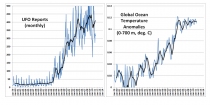
Enlarged
Fig. 1. Time series of monthly UFO reports and global average ocean temperature anomalies from the surface to 700 m depth. Trailing 12 month averages are also shown.
The correlation between UFO reports and ocean temperature is over 0.95, clearly better than the correlation between that boring old carbon dioxide and ocean warming:

Enlarged
Fig. 2. Lag correlations between UFO reports vs. upper ocean temperature, and CO2 versus upper ocean temperature.
In fact, note the tendency for CO2 to follow ocean temperature , suggesting a weak tendency for warming ocean water to outgas CO2 (or reduce the uptake of atmospheric CO2). In other words, warming causes a CO2 increase, versus the common view that CO2 causes warming. In contrast, the peak correlation between UFO reports and ocean temperature is at zero time lag. UFOs visit, the ocean warms.
(And for you alien deniers out there, here’s the spreadsheet with the data and links.)
But correlation isn’t necessarily causation. We need some sort of hypothesized mechanism for how and maybe why aliens cause global warming.
My hypothesis is that the extraterrestrials’ spaceships have some sort of powerful heat generators which are dumping energy into the ocean. Maybe an antigravity-based thermogenic flux capacitor technology (that’s just a guess...I’m only a rocket scientist, not a nuclear physicist or movie star).
But why? Why are the aliens trying to warm our oceans?
Do they come from a warm waterworld? Do they want to colonize our ocean after it is sufficiently heated up? Or are we just the proverbial frogs in a pot of water on the stove?
Clearly, aliens like warmer weather, because there is a strong annual cycle in UFO reports, with the peak number of visitations in July, which is when global average temperatures also peak:
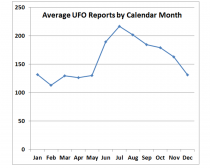
Enlarged
Fig. 3. Average number of UFO reports by calendar month, illustrating aliens’ affinity for warmer weather.
This is also consistent with the fact that aliens are known to not have any fur, let alone any clothes, probably because their home planets are so warm:

Enlarged
Fig. 4. Famous aliens have no fur or clothes, suggesting their home planet(s) are quite warm.
Or, maybe they just like to people-watch. More people are out and about in the summer. That would make abductions easier, too. A two-fer.
On an unrelated matter, I’ve also been working on a new generalized theory of where straight lines come from. Since they are all perfectly correlated with one another, I believe they have a common origin...maybe a super line that extends to infinity and beyond, which generates all other, lesser lines. But the linear algebra is proving to be kinda messy. Stay tuned.
Finally, I’d like to conclude with a quote from Mark Twain:
“There is something fascinating about science. One gets such wholesale returns of conjecture out of such a trifling investment of fact.”
A Closing Thought I talked with Michael Crichton before his death about his experiences getting involved in the global warming debate through his lectures, his book State of Fear (in which John Christy and I were represented by a lady scientist), and his congressional testimony on the subject of climate change. I think he believed he was doing a public service, but the politicization of the issue (and the way he was treated in congress) took him totally by surprise. That left a bad taste in his mouth, and he said he would no longer be involved in the climate issue. This is a crazy business we work in, and most sane people choose not to get involved in the public debate.





